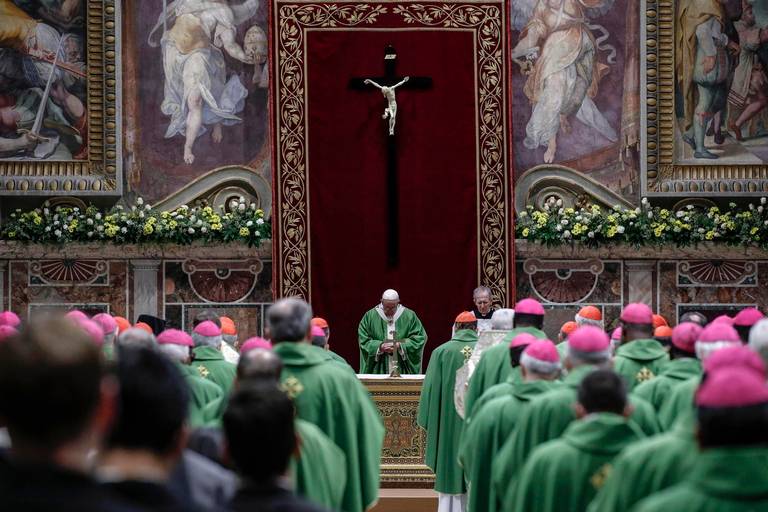|
| Predator Priests: When Will Missouri Scrap Statute of Limitations for Sex Crimes?
Kansas City Star
September 18, 2019
http://kansascity.com/opinion/editorials/article235204647.html
Missouri Attorney General Eric Schmitt has referred the cases of a dozen former Catholic priests accused of sexually abusing minors to prosecutors after a year-long investigation.
That potential for justice for any of those so long denied is appreciated, though it’s impossible to say how many of the dozen men will be charged, much less convicted.
But charges can’t even be pursued against 46 other ex-clergy because the statute of limitations on the allegations against them has expired.
That’s wrong, and it doesn’t have to be this way.
The AG’s inquiry found “credible allegations of 163 instances of sexual abuse or misconduct by Catholic diocesan priests and deacons against minors.” Eighty-three of those accused have died, and of the 80 who are still alive, 46 can’t be pursued without changing the law.
Across the decades and across the country, the Catholic Church has lobbied against such revisions, often successfully.
But knowing all we now know about abuse and how long child victims in particular can take to come to terms with it makes Missouri’s confusing mishmash of statute of limitations on various sex crimes committed during various time frames inexcusable.
This summer, Illinois became the latest state to remove all statutes of limitations on felony sex crimes. The others, according to the Rape, Abuse and Incest National Network, are Kentucky, Maryland, North Carolina, South Carolina, Virginia, West Virginia, Wyoming and the District of Columbia.
Victims in Missouri deserve no less.
“The plaintiff always bears the burden of proof anyway,” said victims’ attorney Rebecca Randles, so the passage of time helps the accused rather than the accuser as memories fade and witnesses become harder to find.
Now that Missouri lawmakers have addressed the urgent needs of car salesmen in a special session that gave them tax credits, might they also do something for those whose lives have been diminished and sometimes destroyed because they were preyed upon as children?
Missouri’s statutes of limitations for sex crimes have already been altered a number of times, but remain a mess that can only be set straight with complete abolition.
Lawmakers should also give the attorney general the power to convene a grand jury on clerical abuse and to subpoena church records.
Schmitt’s 329-page report really only provides snapshots of predator priests who pulled children out of class, Mass, and “even identified victims through the sacrament of reconciliation,” formerly known as confession. His investigation did not look at the long, systemic church cover-up of abuse at all, and he did not reach out to a number of Missouri victims who hoped to be interviewed.
The strictly voluntary, far-from-complete result still shows church efforts to shield and shuffle predators, including one who “appears to have been allowed to relocate outside of the United States” in 2003.
It also shows how the Catholic clergy intimidated and silenced victims, two of whom committed suicide, one of them after his parents said no, he couldn’t stop serving as an altar boy.
And here’s how some of those who survived were treated: In one case, a bishop “attempted to identify the victim in the news media.”
Another victim of a priest responsible for the “severe abuse” of multiple minors “initially reported the incident to the archdiocese,” who urged him to “forgive and forget.’’
Yet another called the archdiocese “to report the abuse but her telephone calls were not returned.”
A woman who as an elementary school student told her confessor that she was being abused by another priest reported that he “admonished her for mentioning abuse.”
The report does criticize the length of time that the Catholic Church can take to defrock, or laicize, a priest: “As a result, this inquiry found numerous priests who committed acts of abuse but who were allowed to remain priests, ultimately receiving retirement, housing, and health benefits from the church. Some continue to enjoy the honorific ‘Monsignor.’ ’’
But galling as that seems, kicking abusers out of the priesthood is not a solution in itself. Cut loose in the world with even less oversight, many find jobs with nonprofits and work with vulnerable people. It may be better that an abuser be called “Monsignor” and kept an eye on than called Mister out on his own somewhere.
The report is only a partial review of personnel records back to 1945 because the attorney general had access to diocesan records and not to those of order priests, like the Jesuits.
So, what now? Schmitt, a lifelong Catholic, calls on the church to organize lay review boards, vet and supervise local order priests and supervise offenders closely. All of that is excellent advice, but as the attorney general’s report itself also notes, the church sometimes fails to meet even the “zero-tolerance” standard for abuse that it adopted in 2002.
Last year, “the bishops rejected many substantive recommendations for reform” and “called for another review in 2025.” Which can always conclude that it should be reviewed again in another five years, or 50.
David Clohessy, the St. Louis-based former national director and spokesman for the Survivors Network of those Abused by Priests, says advising the church to reform won’t accomplish anything. “You might as well tell people to pick up litter, recycle and go to bed on time.”
Only the legal system can answer the soul-killing crimes referred to in the report. And that system desperately needs an update.
 |
Pope Francis celebrates Mass at the Vatican, Sunday, Feb. 24, 2019. Pope Francis celebrated a final Mass to conclude his extraordinary summit of Catholic leaders summoned to Rome for a tutorial on preventing clergy sexual abuse and protecting children from predator priests. GIUSEPPE LAMI THE ASSOCIATED PRESS
|
|